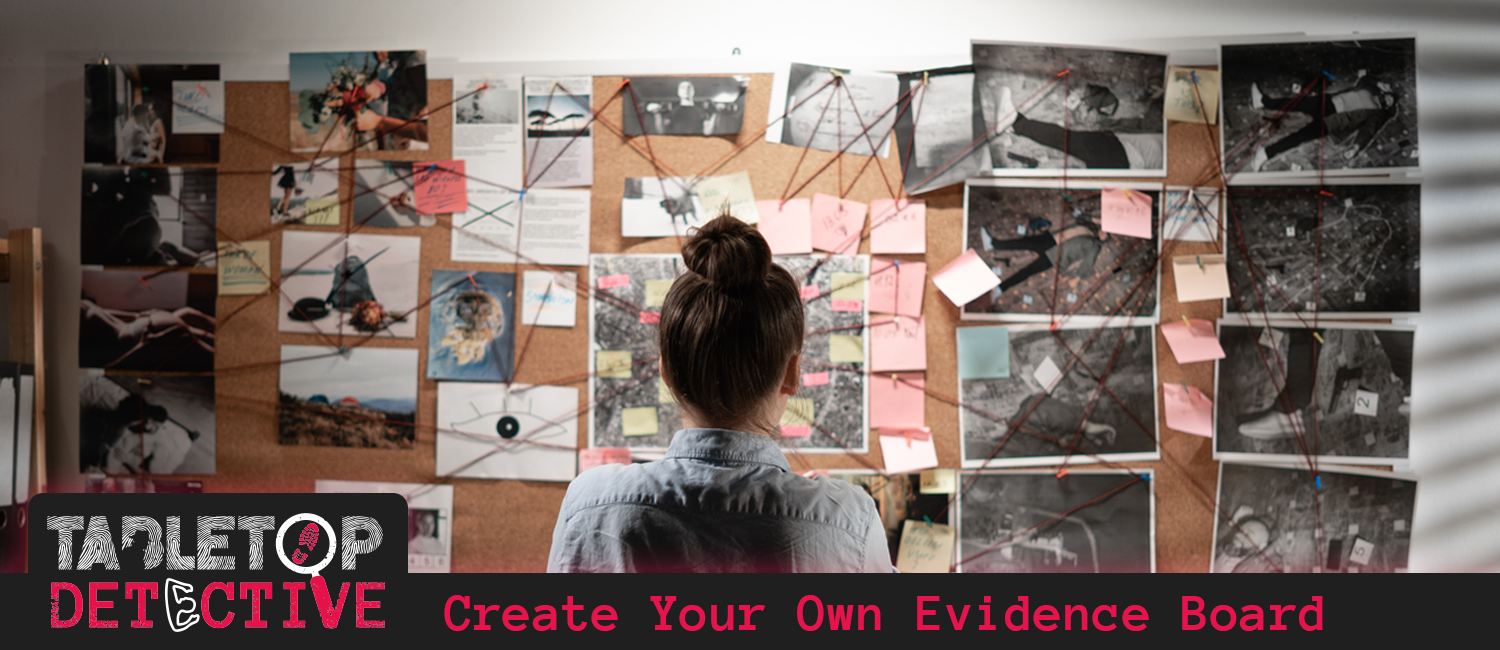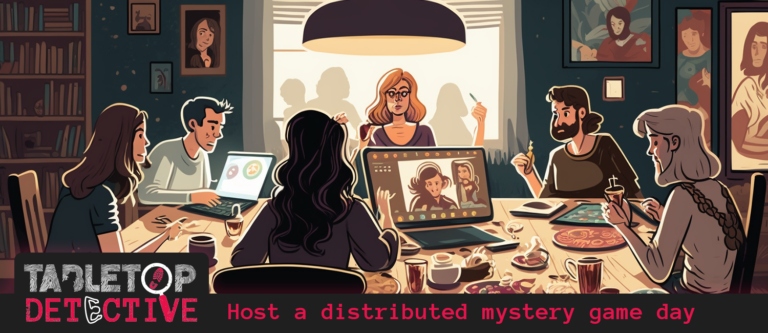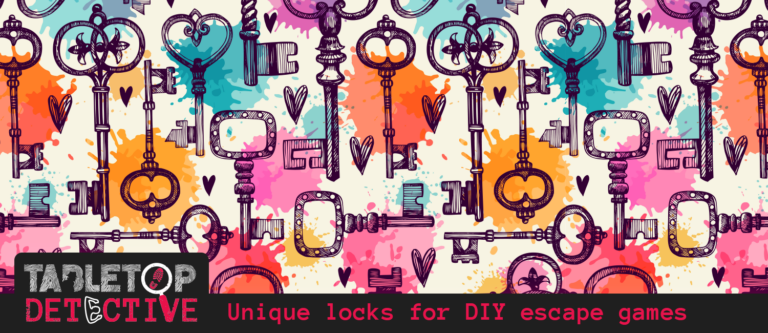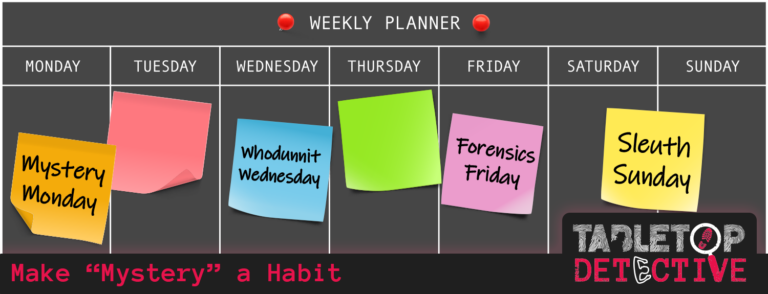Every at-home sleuth needs access to a large, quality evidence board. To solve your toughest cases, you need to jot down notes, pin them up, move them around to organize your suspects, timelines, means, motive, and opportunity until patterns start to emerge.
Whether you build a classic cork board or choose a high-tech alternative, whether you create a permanent fixture in your office (or game room) or need something storage-friendly, you’ll need a few key items to get started.
Board
It’s hard to deny the appeal of a classic cork board with push pins and string. If you’re feeling old-school, grab an oversized cork board and do it up right. Can’t devote permanent wall real estate to your part-time hobby? Tuck the whole thing away in a closet in between mystery nights, evidence and all!
Have an awkward-shaped area available? Cork tiles are a great option for configuring your own evidence board to fit exactly in your space.
If you’re more of a whiteboard type, I suggest getting a magnetic option so you can still grab magnetic “push pins” and keep your options open for organizing your evidence.
- Amazon Basics Cork board 35″ x 47″
- 12″ x 12″ Quartet Cork Tiles (8-pack)
- VIZ-PRO Double-Sided Magnetic Mobile Whiteboard, 48″ x 36″ (comes with magnets, markers, and eraser)
Notecards
Call me old-fashioned, but I love index cards. I usually grab both the standard 3″ x 5″ and the half-sized version for different types of info. They’re the perfect size for both jotting down broad concepts on the plain side–like prime suspects, or open questions–and adding supplemental notes on the lined side. Pin them up, move them around. See the big picture.
Use different colors to code your categories of information. Blue for timelines. Red/pink for suspects. Yellow for motives. Green for witnesses. Regular white cards for questions, observations, and details about your other categories. But do whatever works for you.
But if you’re more of a Post-It sleuth, that’s fine too. You should still pick up a small variety of distinct colors and develop a system to visualize the details of your case. I recommend standard squares for broad concepts and larger, lined versions for more detailed notes. And if you plan to store your whiteboard in between sessions, make sure you get the “Super Sticky” version so they don’t fall off.
Here are some great options on Amazon:
- Oxford white 3″ x 5″ index cards (300-count)
- Oxford rainbow 3″ x 5″ index cards (200-count)
- Oxford rainbow 3″ x 2.5″ half-sized index cards (200-count)
- Post-it Super standard 3″ x 3″ Sticky Notes in Playful Primaries
- Oversized Post-it 4″ x 6″ lined Super Sticky Notes in Playful Primaries
Pins
Once you get beyond fundamental “literal pointy pins for cork boards” vs. “magnetic pins” decision (which you made at the “choosing your board” stage), the pins you choose are mostly a style preference. What looks like an evidence board to you?
Do you prefer chunky, classic push pins? Do you like the style of pins with small round heads? Do you want something fancier, like a pin with a clip, so you don’t damage your evidence? Prefer a more low-profile thumbtack for easy storage? This choice is really up to you.
I think the shape of a classic push pin lends itself better to the “red string spiderweb” aesthetic I consider synonymous with “evidence board”, so that’s my personal preference. But choose what you like.
Here are some great options on Amazon:
- AmazonBasics 100-count push pins (100-piece set)
- Multicolored Wooden Clips Push Pins Clips (36-piece set)
- Multi-Color Map Push Pins (600-piece set)
- Push Pins Variety Pack (200-piece set)
- Colorful Push Pin Magnets (90-piece set)
Red string
When you picture stereotypical detectives obsessed with piecing together details of the complex mystery they can’t let go, few images spring to mind more readily than the spiderweb of red string. Capturing that feeling for yourself, and visualizing the connections between information of your own cases, starts with $5 and a trip to the yarn store.
But here are some great options on Amazon:
Markers
I say “markers”, rather than “writing utensils” because evidence boards need to make sense when you step back and look at the big picture. Which means you need bold, readable notes, whether you use notecards, Post-Its, or write directly on a whiteboard.
While I love a good permanent Sharpie as much as the next Detective, you want a marker than won’t bleed through your paper. For that, I like flipboard markers. They’re chunky, with bold strokes, but made for lighter-weight paper.
And for your more detailed notes, it’s hard to go wrong with a great felt-tip flair, like a Paper Mate.
Here are some great options on Amazon:
- Staedtler Lumocolor Flipchart Markers 8-pack (super high quality)
- Sharpie brand Flip Chart Marker, Bullet Point 8-pack
- Paper Mate Flair Black 12-pack
- EXPO Dry Erase Marker Kit (with 2 sizes of markers, eraser, and cleaning spray)
Other useful tools
Here are some optional, but useful, additions to your evidence board setup.
Sticky flags
Great for calling out information in mystery-specific documents, use sticky flags in conjunction with your color-coding scheme for your notes.
Page protectors
I promise, this isn’t just me trying to justify my “obsessed with page protectors” phase in college. If you don’t want to puncture your mystery-specific documents with push pin holes, or perhaps worry about marker-happy kids in between sessions, some binder-friendly page protectors can help preserve your important papers.
Binder clips
If you’re not a fan of page protectors, binder clips can be a great alternative way to pin up documents without punching holes directly in the pages. Clip the binder clip, and leave one end flipped up so you can hang on a pin, or pin through the loose end. Bonus benefit over page protectors? Find a variety pack of binder clips that matches your evidence-organizing color scheme!
Portfolio case
This one is a bit of an indulgent splurge, I’ll admit. But if you need to store your evidence board between sessions, a quality portfolio case (made for artists to store and transport their work) can be a great option for protecting and transporting your evidence board in between game nights. Just make sure your documents are secured to the board, and opt for low-profile pins.
Printer/copier
We already have a high-quality printer, scanner, copier in the house for business purposes, so this might be one of those “upgrade later” items for you. Or maybe you need to wait until your current printer needs replacing anyway. But consider a printer with a built-in copier for copying documents that come with your pre-made mysteries. I can’t tell you how many times we do this, even if games come with a pre-made refill kit. There are thousands of different options, in every price range, so I’ve simply linked to an updated model of the Brother one we’ve had, and loved, for over 8 years.
All-in-one solution
And in case you’re just looking for a one-and-done purchase, consider the Murder Board Kit from Hunt-A-Killer. Their all-in-one solution includes everything you need to get started, including cork tiles, red yard, pins, sticky flags, highlighters, and page protectors.
Grab your own Murder Board Kit from Hunt-A-Killer‘s web store.
Evidence board tips
Here are some tips for making the most of your evidence board, and the documents you use it for, no matter how you choose to build and store it.
Start small
Remember, your objective is to organize your thoughts and visualize the details of your mysteries. You don’t need to spend a ton of money to do that.
Even if you only have a small patch of wall, you can cobble together an evidence board with minimal expense. Grab some Post-Its for notes, and a bit of poster putty for hanging the documents that come with your mystery, and you’ve got enough to get started! You can always invest in enhancing it over time.
Make the most of gifting holidays
If you’re anything like me, your friends and family never know what to get you. Especially if you’re starting small, you can decide on your ideal setup and create an Amazon wish list, so friends and family can contribute to your hobby. Gifting holidays are also a great way to upgrade your setup as you learn what works for you and your fellow sleuths.
Make copies
Especially when we’re dealing with high-quality mystery games, like Emerald Flame, we often make copies of our documents so we don’t destroy the originals pinning them up. Extra copies also help us work together on tricky puzzles, let us work through solutions right in the document, or even cut them up or fold them to look at things from different perspectives.
Some quality games come with refill packs so you can “reset” and regift after you’ve solved it. But if you didn’t splurge for the refill kit, or one isn’t available, quality copies can help keep your game in-tact. If you don’t have a printer/copier at home, bring your game to your local copy shop before you start and invest in 2-3 quality copies of each document per player. Trust me.
Track your progress
Even if you’re not solving a larger case with multiple episodes, like Hunt-A-Killer or Detective Society boxes, you might find yourself needing to take a break in between sessions. Throughout your sessions, snap the occasional picture to document your progress and current thoughts.
That way, if your sticky notes fall off, your kids decide to unpin your notes and put up their latest artwork, your closet wasn’t the safe haven you expected, or you simply went down an unhelpful rabbit hole, you can easily reconstruct your evidence board.




